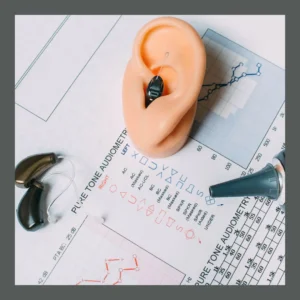Addressing Hidden Hearing Loss: What You Need to Know
Hearing loss varies from high-frequency loss to central auditory issues. High-frequency hearing loss often affects older adults and those exposed to loud noises. However, there’s another type of hearing loss that isn’t as well-known: hidden hearing loss.
What Is Hidden Hearing Loss?
Hidden hearing loss isn’t detectable on standard hearing tests. It affects how the nervous system processes sound, leading to difficulties that typical tests don’t reveal. Interestingly, about 10% of patients with normal audiograms still experience significant hearing difficulties, suggesting hidden hearing loss could be more common than previously thought.
Recognizing Hidden Hearing Loss
People with hidden hearing loss often struggle with understanding speech in noisy environments. They find it challenging to follow conversations with multiple speakers or pick out specific sounds against background noise. This condition can be frustrating as it impacts daily communication.
Common signs of hidden hearing loss include feeling you have hearing loss despite normal test results. Individuals prefer quiet settings for conversations and struggle to focus in noisy environments. They often misinterpret what people say, adding to the difficulty of engaging in social interactions.

How Is Hidden Hearing Loss Diagnosed?
Diagnosing hidden hearing loss requires comprehensive tests beyond standard audiograms. Extended high-frequency audiograms, otoacoustic emissions (OAE) tests, and speech-in-noise (SIN) tests are crucial in identifying this condition. These tests examine the ear’s response to sound and the ability to understand speech amidst noise.
Find out more about audiograms.
Causes Behind Hidden Hearing Loss
Several factors contribute to hidden hearing loss. Noise exposure, head trauma, and age-related changes can all play a role. Ototoxic medications and genetic predisposition are also potential causes. Researchers are actively investigating these factors to develop better diagnostic tools and treatments.
Daily Life Impact
Hidden hearing loss significantly affects daily life. Communication becomes challenging, especially in noisy environments, leading to social isolation. Effortful listening can cause fatigue and strain, making it difficult to enjoy social interactions.
The social and emotional effects are profound. Difficulty in communication can lead to anxiety, reduced confidence, and even depression. In professional and educational settings, individuals with hidden hearing loss might struggle to participate in meetings or follow lectures, impacting their performance and academic success.
Managing Hidden Hearing Loss
Managing hidden hearing loss involves a combination of strategies and tools to improve communication and reduce the impact on daily life. While there is no cure, various approaches can help those affected.
Communication Techniques
- Seek Quiet Environments: Choosing quiet conversation settings can significantly improve your ability to understand speech. Opt for quieter restaurants or cafes, and select seating away from noisy areas.
- Ask for Repetition: Don’t hesitate to ask people to repeat themselves if you miss something. Most people are happy to rephrase or speak a little slower to improve clarity.
- Face the Speaker: Lipreading combined with listening can significantly enhance your understanding, especially in noisy environments. You can pick up on visual cues that aid comprehension by facing the speaker.
- Reduce Background Noise: Whenever possible, minimize background noise sources like the TV or radio when having conversations. This can help you focus better on the person speaking.
Assistive Listening Devices
- Personal Amplifiers: These portable devices can amplify sounds in your immediate environment, making conversations clearer. They are instrumental in one-on-one conversations or small group settings.
- FM Systems: FM systems consist of a transmitter worn by the speaker and a receiver worn by the listener. The transmitter directly transmits the speaker’s voice to the receiver, bypassing background noise and improving speech clarity in lectures, meetings, or classrooms.
Hearing Aids
Hearing aids play a crucial role in managing hidden hearing loss, even though traditional hearing tests might show typical results. Advanced hearing aids come with specific features designed to help those with hidden hearing loss:
- Directional Microphones: These microphones focus on sounds coming from directly in front of you, where the speaker is likely positioned while reducing noise from the sides and back. This feature is particularly helpful in moderately noisy environments.
- Noise Reduction Features: Hearing aids with advanced noise reduction algorithms can help suppress background noise and improve speech clarity. These features are essential for those struggling to hear in noisy settings.
- Speech Enhancement Features: Some hearing aids incorporate features that emphasize speech frequencies, making them more prominent compared to background noise. This can significantly enhance your ability to understand conversations.
- Bluetooth Connectivity: Modern hearing aids often come with Bluetooth connectivity, allowing them to connect to smartphones, televisions, and other devices. This can stream sound directly to your hearing aids, providing clearer audio for phone calls, music, and more.
- Customizable Programs: Many hearing aids offer customized programs tailored to different listening environments. You can switch between programs for quiet settings, noisy environments, and other specific situations, ensuring optimal hearing in various scenarios.
- Telecoil Technology: Telecoil technology allows hearing aids to connect directly to compatible sound systems in public places like theaters, churches, and lecture halls. This can enhance your listening experience in these venues by directly transmitting sound to your hearing aids.
- Professional Support: Finding a healthcare provider knowledgeable about hidden hearing loss is crucial. They can recommend the proper devices or mobile applications to aid your hearing based on your individual situation. Regular follow-ups with an audiologist can help fine-tune your hearing aids and adjust your management plan as needed.
Understand more about how hearing aids help with speech in noise.
Environmental Adjustments
- Home Adjustments: Make your home more hearing-friendly by reducing background noise and using visual cues. Soft furnishings can help absorb sound and reduce echo, making it easier to hear.
- Social Strategies: In social situations, try to position yourself where you can see people’s faces clearly. Small group conversations are often easier to follow than large gatherings.
- Technology Use: Consider using mobile apps that provide live captioning during conversations. These apps can transcribe spoken words into text, allowing you to read what others say in real-time.
- Protecting Your Hearing: Preventing further damage is crucial. Use hearing protection in loud environments, such as concerts or noisy workplaces. Custom earplugs or noise-canceling earmuffs can be very effective.

Take Action for Better Hearing
Hidden hearing loss, while challenging, can be managed with the right strategies and tools. If you suspect hidden hearing loss, consult a qualified hearing professional for a comprehensive evaluation.
Take the first step towards better hearing. Contact Stanford Hearing today for a thorough hearing assessment and personalized solutions.
